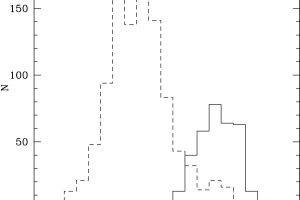A search for binary systems with GES. The study “The Gaia-ESO Survey: double, triple, and quadruple-line spectroscopic binary candidates” by T. Merle recently appeared on A&A

The study of binary systems plays an important role in several fields of astronomy such as stellar evolution and galactic archeology since it allows direct measurements of stellar parameters such as masses, radii, and luminosities.
Multiple stellar systems have typically small angular separation and thus they are not resolved by direct imaging. In these cases spectroscopy is a powerful tool for detection and diagnostics. Spectra of multiple components contain in fact the spectra of each star in the system, allowing not only the identification of the system but also the analysis of stellar spectral type.
Several catalogs of multiple stellar systems exist. For instance, the Geneva-Copenhagen Survey catalog contains approximately 4000 binary systems with a single-component spectrum (SB1), where the binary system is revealed by doppler shift of stellar lines, 2100 systems with two components spectra (SB2), and 60 three components systems (SB3), over a total of 16700 F and G stars in the Solar neighborhood.
In the study “The Gaia-ESO Survey: double, triple, and quadruple-line spectroscopic binary candidates” of T. Merle (Institut d’Astronomie et d’Astrophysique, Université Libre de Bruxelles) the rich spectroscopic database of the Gaia-ESO Survey (GES) is used to search for multiple stellar systems. Thanks to a newly developed method for the analysis of the cross-correlation function between GES spectra and template stellar spectra, the authors have identified 354 multiple stellar systems, among which 342 SB2, 11 SB3, and one SB4. Almost all these systems (98%) have been discovered for the first time. Besides, a complete orbital solution is found for two SB2 systems (V642 Mon in NGC 2264 and CNAME 19013257-0027338 in Berkeley 81) and the SB4 system is analyzed in details. The astronomers Francesco Damiani and Ettore Flaccomio of the Astronomical Observatory of Palermo have participated to the study. The paper describing the study has been recently published by Astronomy and Astrophysics.
The figure (link) shows the magnitude distribution of the SB2 systems from GES and the Ninth Catalogue of Spectroscopic Binary Orbits, together with the SB3 systems from GES
